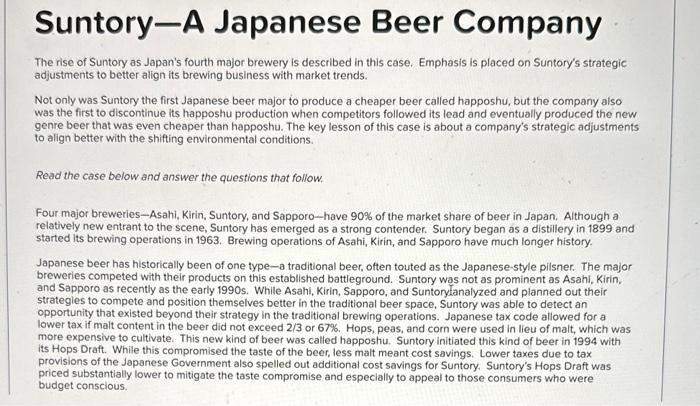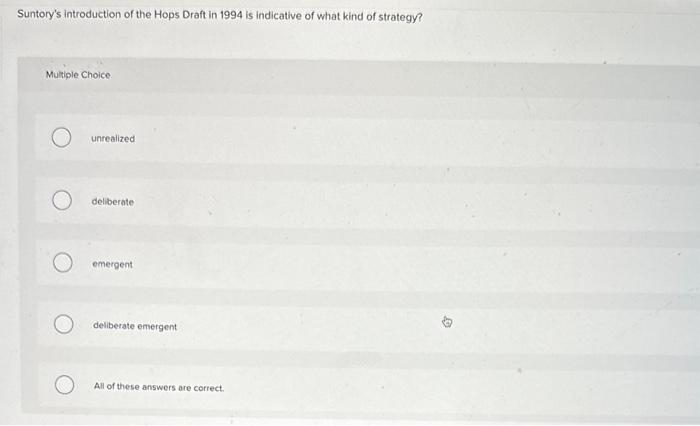The rise of Suntory as Japan's fourth major brewery is described in this case. Emphasis is placed on Suntory's strategic adjustments to better align its brewing business with market trends. Not only was Suntory the first Japanese beer major to produce a cheaper beer called happoshu, but the company also was the first to discontinue its happoshu production when competitors followed its lead and eventually produced the new genre beer that was even cheaper than happoshu. The key lesson of this case is about a company's strategic adjustments to align better with the shifting environmental conditions. Read the case below and answer the questions that follow. Four major breweries - Asahi, Kirin, Suntory, and Sapporo-have 90% of the market share of beer in Japan. Although a relatively new entrant to the scene, Suntory has emerged as a strong contender. Suntory began as a distillery in 1899 and started its brewing operations in 1963. Brewing operations of Asahi, Kirin, and Sapporo have much longer history. Japanese beer has historically been of one type-a traditional beer, often touted as the Japanese-style pilsner. The major breweries competed with their products on this established battleground. Suntory was not as prominent as Asahi, Kirin. and Sapporo as recently as the early 1990 s. While Asahi, Kirin, Sapporo, and Suntoryanalyzed and planned out their strategies to compete and position themselves better in the traditional beer space, Suntory was able to detect an opportunity that existed beyond their strategy in the traditional brewing operations. Japanese tax code allowed for a lower tax if malt content in the beer did not exceed 2/3 or 67%. Hops, peas, and corn were used in lieu of malt, which was more expensive to cultivate. This new kind of beer was called happoshu. Suntory initiated this kind of beer in 1994 with its Hops Draft. While this compromised the taste of the beer, less malt meant cost savings. Lower taxes due to tax provisions of the Japanese Government also spelled out additional cost savings for Suntory. Suntory's Hops Draft was priced substantially lower to mitigate the taste compromise and especially to appeal to those consumers who were budget conscious. After Suntory's initial success with happoshu, Asahi, Kirin, and Sapporo followed suit throughout the 1990 s and carved out their respective stakes in the happoshu business. However, Suntory's market share increased and by the mid 2000 s, Suntory caught up with Sapporo in market share. By late 2000 s, a third kind of beer was on the rise that had no malt. This approach lowered production costs even more and also exploited additional tax reductions. These new genre beers were priced even lower than happoshu and as a result, happoshu sales started to shrink. At about the same time, the craft beer revolution was quietly starting to brew with microbreweries. While Asahi, Kirin, and Sapporo continued with their happoshu business and even entered the business space of new genre beers, in 2012 Suntory surprised its competitors by announcing that it was getting out of its happoshu beer business. Unlike the paths followed by its competitors, Suntory focused more on its premium beers that used malt as Its primary ingredient. Other malt beverages also recelved substantial focus, and in recent years Suntory whiskey has made major inroads into the premium whiskey market of the US. By 2015, Suntory's market share placed it in a formidable third position, with Sapporo moving to a distant fourth and even Kirin losing some market share. Suntory's introduction of the Hops Draft in 1994 is indicative of what kind of strategy? Multiple Choice. unrealized deliberate emergent dellberate emergent All of these answers are correct









